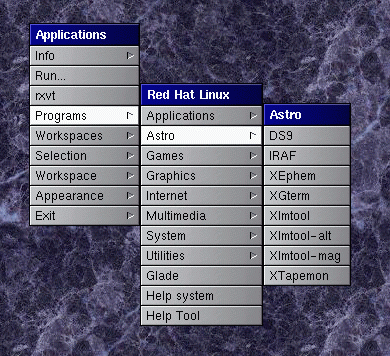
rpm -Uvh *.rpm
to install them to your system. You may now delete the package files from the temporary directory.
Now, depending upon what desktop you use, IRAF and DS9 icons are integrated into your desktop. Below is an image of a WindowMaker desktop with the new "Astronomy" Menu, under Redhat 7.1. The same is done for GNOME and KDE. All wmconfig-aware window managers should work fine too.

First, if you've not run IRAF before, set up your user account to run IRAF by running mkiraf. Tell it you're running an xgterm, when it asks.
If you want to use the reduction scripts I have written or modified, you will need to download them somewhere on your system and add the following lines to your loginuser.cl file:
reset phoenix = home$scripts/phoenix/ task $phoenix.pkg = phoenix$phoenix.clYou could put those declarations in login.cl if you don't want to use loginuser.cl. Other things you may want to set in login.cl might be:
set imtype = "fits" set stdimage = imt14
[Aside: Type !stty erase ^H in IRAF if you despise the behavior of the backspace and delete keys.]
So go ahead, start IRAF and DS9 and let's get busy...
The IRAF group has written a number of excellent documents on basic reduction of CCD observations, either for the purposes of photometry or spectroscopy. The latter is especially relevant to our purposes, and I recommend that you flip through it now. Really.
You're just going to ignore my suggestion, aren't you? Okay, very well. But don't say that I didn't warn you. :)
The IRAF command prompt window provides a rudimentary interface to the bewildering array of tasks it provides. Tasks are typically organized into related groups called packages which may be loaded by typing the package name and unloaded by typing bye. Although you can run a task by willy-nilly typing its name, you don't know what it's going to do. Most IRAF tasks are flexible (read: complicated) and the default behavior may not be what you want. So, typically you will edit its parameters (using a command unimaginatively called epar) to tune the task to your purposes before running it.
Getting Help in IRAF: Don't panic! You can learn about any task by typing help [taskname]. Within most interactive tasks, you can hit ? and a help window will pop up with a quick reference to keyboard commands.
 About Tutorial Spectra About Tutorial Spectra |
Constructing Dark Frames  |